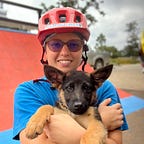Storyge — The Immersive Experience Design Workflow
Part C of ‘The Immersive Experience Designer’s Palette Introduction’
Just like the painter’s palette pioneered UX for painters, ‘Storyge’ aims to pioneer UX for Immersive Experience Designers.
My Immersive Experience Design Workflow:
- Wherever I go I Document Sensory Inputs.
- This enables me to work from an Archive of Moments.
- From which I then create specific Experience Palettes.
- I then use the Experience Palette to create an Immersive Experience Prototype.
- Using the Immersive Experience Prototype as guide, I can finally go ahead and jump into the Immersive Experence Production phase of the experience.
Unfortunately there’s still quite a few more things to smooth out in terms of making Immersive Experience Design as intuitive as the above workflow suggests.
Current Workflow Challenges:
Just as a painter needs a palette board, Immersive Experience Designers need a multimedia, multi-format, Immersive Experience palette tool.
“If you were a painter back in the early Medieval days, you’d have to separate your precious pigments into several bowls and line them up along your workspace, running the risk of accidentally mixing paints (and evidently, having lots of dishes to wash). This inefficiency evidently led to the development of the artist’s palette, which offered painters greater mobility and productivity in their craft.”*1
Somehow it is always hard to believe people ever existed before the tools we are so used to today were ever invented.
However we forget that we are in a state of perpetual change, and just like the artisans of eras past, artisans now also face similar difficulties as described above.
Just as pre-🎨 painters ran “the risk of accidentally mixing paints (and evidently, having lots of dishes to wash),” because they had to separate their “precious pigments into several bowls,” —
Immersive Experience Designers currently run the risk of:
- Physical objects bogging us down, because we get stuck in the unfortunately still very messy and limiting world of Analogue vs Digital.
- Storage Programs’ limiting format incompatibilities separating project archives, making us have to switch through various interfaces and thus making us lose our precious creative focus.
- Storage Programs’ limiting format incompatibilities separating project archives, making us struggle to sieve through our diverse inventories and create and access a tailored database of items to included in the experience.
- Immersive Experience Production Programs making it difficult to compare various versions of one experience, making us not able to choose and merge the best samples from various versions.
- Immersive Experience Production Programs not incorporating sufficient access to version histories, thus forcing us to lose valuable time by having to manually archive and view previous versions of projects.
- Immersive Experience Design Programs limiting overall experience harmonization, as we cannot traverse drafts of the different avenues within our non-linear and interactive scripts while designing.
- Immersive Experience Design Programs making it impossible to create non committal version examples, ultimately creating folders upon folders with duplicates, multiple versions of edits and gigs upon gigs of proxies, uncompressed masters and all kinds of ways of wasting valuable data storage space!
You see, there really is quite a lot of work to be done.
Thus far, we are working on various ways of solving the above pitfalls.
Read all about it in the follow up blog ‘Storyge — Towards a solution’.
Other blogs in this series
A) The Immersive Experience Designer’s Palette
B) An introduction to Immersive Experience Design
C) The Immersive Experience Design Workflow
D) Storyge — Towards a solution
More about the author:
Carla Inez Espost currently consults, trains, produces, manages and creates Immersive content for Little Kidogo.
Little Kidogo is a distributed collective of world-class professionals on an ambitious mission to enhance lives through enabling African artisans to live off their work.
“We spend our time building bleeding-edge products that we believe will enrich our lives and the lives of the communities we live in. We are working to enable more Africans to become producers of digital content rather than consumers. We believe we can achieve this goal by actively sharing our learnings and the methods we utilize day by day to build great products.”
